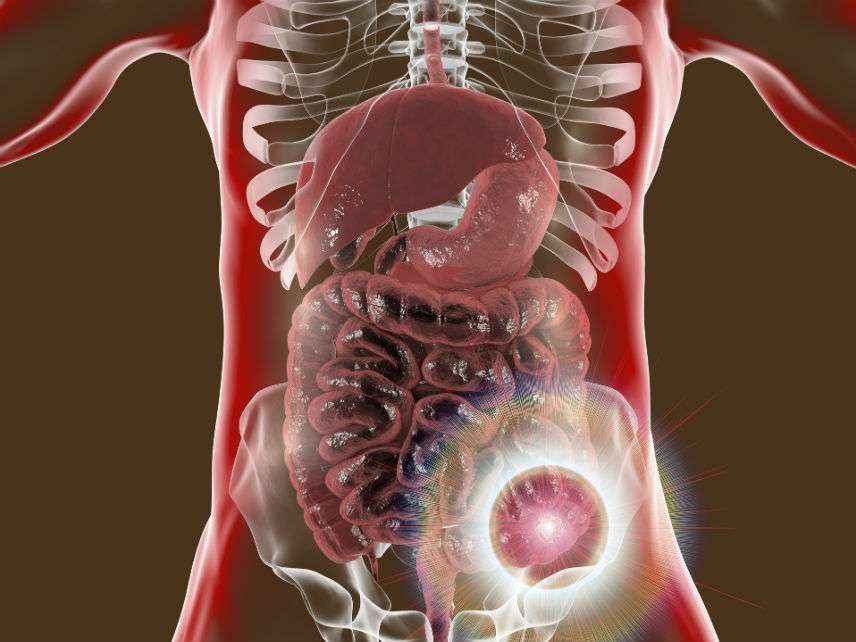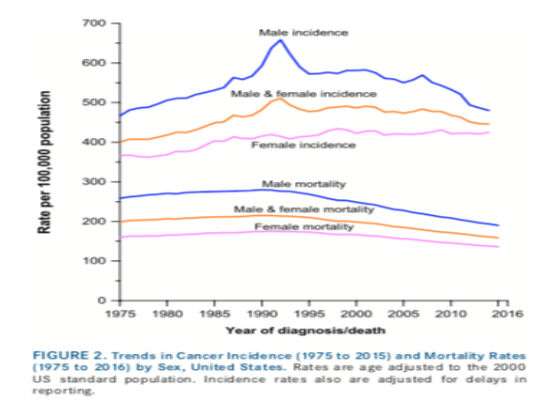U.S. Cancer Incidence and Death Rates Fall to a 25-Year Low
Good news: The cancer death rate which stood in 1991 at 215 per 100,000 people has dropped in 2016 to 156 per 100,000 people.

"The overall cancer death rate dropped continuously from 1991 to 2016 by a total of 27 percent, translating into approximately 2,629,200 fewer cancer deaths than would have been expected if death rates had remained at their peak," notes the American Cancer Society (ACS) in its latest annual update of cancer mortality and incidence statistics. In 1991, the cancer death rate stood at 215 per 100,000 people and has fallen in 2016 to 156 per 100,000 people. The report also notes that the cancer death rate between 2007 and 2016 for both women and men declined annually by 1.4 and 1.8 percent, respectively.
In addition, the ACS reports that the cancer incidence rate between 2006 and 2015 for women has been stable while dropping by approximately 2 percent per year for men. In other words, the modern world is not producing an epidemic of cancer as predicted by so many activists.
Most of the decline in both incidence and mortality is due to reductions in smoking tobacco (which increases the risk of a number of cancers, particularly lung cancer) and advances in the early detection and treatment of cancer. According to the report, LiveScience notes, lung cancer death rates have dropped by 48 percent among men from 1990 to 2016; and 23 percent among women from 2002 to 2016. Breast cancer death rates dropped 40 percent among women from 1989 to 2016; prostate cancer death rates dropped by 51 percent among men from 1993 to 2016; and colorectal cancer death rates dropped by 53 percent among both men and women from 1970 to 2016. The reduction in death rates for breast, prostate, and colorectal cancer reflect the use of screening tests that result in earlier detection and, in the case of colorectal cancer, the removal of precancerous polyps during colonoscopy.

The news is not all good, however. Incidence rates for melanoma, liver, and thyroid cancers in men and women since 1975 have trended slightly upwards.
The report does also note that compared with the most affluent counties, mortality rates in the poorest counties were two-fold higher for cervical cancer and 40 percent higher for male lung and liver cancers during 2012-2016.
Overall, the chances that an American man will be diagnosed with cancer before age 49 is 1 in 30, rising after age 70 to 1 in 3. For American women the chances of being diagnosed with cancer before age 49 is 1 in 18, rising after age 70 to 1 in 4. Still, the lifetime probability of being diagnosed with invasive cancer is slightly higher for men (39.3 percent) than for women (37.7 percent).
The report notes that the disparity between men and women is possibily associated with sex differences in immune function and response. Adult height is also positively associated with cancer incidence and mortality in both men and women, and has been estimated to account for one-third of the sex disparity.*
*Disclosure: This correlation is annoying given that I am six feet and five inches tall.
Editor's Note: As of February 29, 2024, commenting privileges on reason.com posts are limited to Reason Plus subscribers. Past commenters are grandfathered in for a temporary period. Subscribe here to preserve your ability to comment. Your Reason Plus subscription also gives you an ad-free version of reason.com, along with full access to the digital edition and archives of Reason magazine. We request that comments be civil and on-topic. We do not moderate or assume any responsibility for comments, which are owned by the readers who post them. Comments do not represent the views of reason.com or Reason Foundation. We reserve the right to delete any comment and ban commenters for any reason at any time. Comments may only be edited within 5 minutes of posting. Report abuses.
Please to post comments




That seems like good news... New technologies having given rise to panic is nothing new! Still, seems like women are more likely to get diagnosed with cancer, being 1 in 18, but I've heard men overall statistically have shorter life spans on average. Luckily, no one in my family ever had cancer run in the family and only got some forms in old age, such as my grandparents who still were very elderly in their mid 90's when it struck. A factor in caner uptick might be simply people are living long enough to develop those mutations versus throughout history when people had shorter life expectancies.
ALoR: A Harvard cancer researcher once told me that if something else does not kill us, then every one of us would eventually get cancer. For the most part it's a disease of aging.
BTW, just a word of warning - just because your family has no history of cancer doesn't mean you're home free. A very dear friend of mine with no family history of cancer has just been diagnosed with stage 4 colon cancer. So don't neglect getting a colonoscopy!
This correlation is annoying given that I am six feet and five inches tall.
You're not going to live forever, Ron.
Awesome. Nice to find some good news.
They did note a rise in liver cancer. That may change for the better as one of the major risk factors, hepatitis C is treatable now.
What's that little bubble in the early 1990s for male incidence? All but the female incidence also seem to peak around then, but without the distinct bubble.
The article attributed that to PSA testing for prostate cancer.
Which they are doing less now. More aggressive approach in late 80s and 90s. They found a lot of tumors that were cancer under the microscope but as more data came in they were doing more harm than good.
Current recommendations if anyone is interested.
https://tinyurl.com/ya3umn3g
I'm opposed to cancer.
I am a tiny bit of evidence of the decline. After surgery for colon cancer in 1991 (I was 50) and another smaller surgery in 2003, I'm still here. 🙂
I essentially started three weeks past and that i makes $385 benefit $135 to $a hundred and fifty consistently simply by working at the internet from domestic. I made ina long term! "a great deal obliged to you for giving American explicit this remarkable opportunity to earn more money from domestic. This in addition coins has adjusted my lifestyles in such quite a few manners by which, supply you!". go to this website online domestic media tech tab for extra element thank you......
http://www.geosalary.com
Death rates going down is good... But instances of getting it in the first place are more important, and what are actually relevant to whether or not cancer is increasing.
From data I have read it seems some are going down, like smoking related... But that is an obvious no brainer. A lot of other cancers have been inching up, especially certain weird ones.
MORE important than what has happened since the peak, is where were things BEFORE the peak. We're still waaay over the rates for many types of cancer back a few decades earlier. Some of this may be better diagnosis, as in they missed it back in the day... But probably not all.
I'm not a doctor, but it seems logical to conclude that the near bathing in chemicals we do in the modern world contributes to some of this. Logic would dictate that out of the many thousands of man made chemicals that are now everywhere in the world, some would actually be innocuous... But others would be harmful. It's just law of averages if nothing else.
So I'm still super on board with continued testing of a lot of these things to sort the wheat from the chaff. If we didn't do the studies, we'd still not know about asbestos, smoking, BPA, etc. We don't necessarily need to go to full on precautionary principle with this stuff, but to just assume all new chemicals are safe is just as flawed a view.